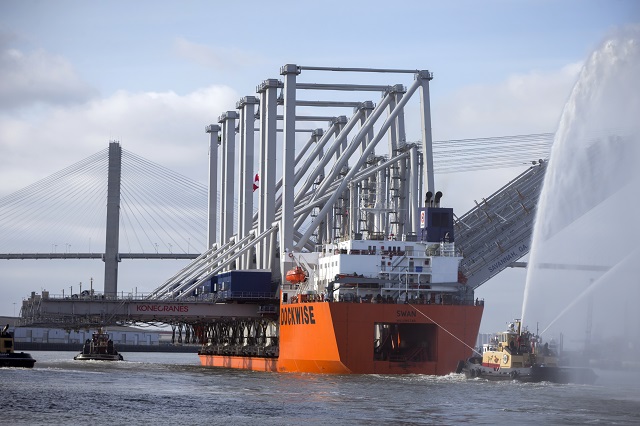Savannah Welcomes Four More Neo-Panamax Cranes
Four additional Neo-Panamax cranes arrived at the Port of Savannah last week, with a 50 by 100 foot American flag across the side.
The Neo-Panamax cranes are tall enough to lift containers 152 feet above the dock. The booms reach out 192 feet from the dock face. Lift capacity for each crane is 72 tons. With the booms up, the cranes are 412 feet tall. The crane fleet operates over nearly 10,000 contiguous feet of dock and nine berth spaces.
Once commissioned, the new cranes will bring Savannah's fleet to 30. Six additional cranes will arrive in 2020. When all are commissioned, the upgrade will allow the nation's largest single container facility to move nearly 1,300 containers per hour.
Chief Operating Officer for Georgia Ports Authority Ed McCarthy said the advantage of these new cranes will be multiplied by several other ongoing infrastructure improvements, including the Mason Mega Rail Terminal. That project will double the Port of Savannah's annual rail lift capacity to one million container lifts, and expand the port's reach into the Midwest.
"These new cranes will prepare us for the next wave of growth for Georgia and the nation," McCarthy said. "Nearly two-thirds of the ships serving the Port of Savannah are Neo-Panamax vessels, and we expect the shipping lines to continue their shift toward larger vessels."
The first of the new cranes will go into service in February. Two more will be commissioned in March, with the final crane going into service in April. The investment totals $47 million.
Georgia Ports Authority reported 32 percent growth in containerized trade for October, an all-time record for Savannah, with the Authority approving rail and gate expansion projects that will significantly increase capacity at its Garden City Terminal – the single largest container terminal in all of North America.

that matters most
Get the latest maritime news delivered to your inbox daily.
In addition to record container volumes, total tonnage for all terminals climbed by 25 percent, from 2.6 million to 3.2 million tons, for an additional 661,290 tons of cargo. Breakbulk tonnage, primarily the movement of lumber, steel and autos, also increased by 14.7 percent.

